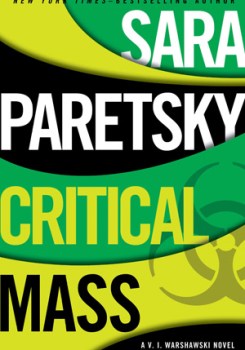A Novelist Inspired by Physicist-Muses
Author Sara Paretsky describes the scientific influences on her new crime detective novel, “Critical Mass.”
When I was nine, George Gamow stopped for a night in Lawrence, Kansas. Gamow was one of the great physicists of the 20th century, whose work was central to the success of the Manhattan Project. Why he came to Kansas, how he ended up spending the night in our home, I never will know, although his only child was a cell biologist, as was my dad—perhaps they had met.
Gamow was an enthusiastic horseman and he traveled with his saddle. My brothers and I were photographed pretending to ride on it. Gamow taught us card tricks, which I don’t remember, and a limerick describing relativity, which I do.
Years later, when I was first dating Courteney, the University of Chicago physicist I eventually married, I recited the limerick*. Courtenay made a face and said everyone in the physics world knew it. When he learned who had taught it to me he was somewhat less contemptuous.
I’ve spent my life around science and scientists, envious and admiring of what Richard Feynman called their “Pleasure of Finding Things Out.” A complex integral could so absorb my husband that he blotted out fighting children, barking dogs and a loud TV in the next room. I long for the ability to become so interior that I don’t notice such distractions.
We didn’t talk about science and math education when I was growing up, but there weren’t a lot of women around me doing science. When I created Martina Saginor, the physicist at the center of my new novel, Critical Mass [discussed on Science Friday here], I was imagining a woman whose longing for the harmonies gave her the single-minded absorption I’d seen in my husband and his friends.

I also was responding to my own excitement at learning about a missing chapter in women’s science history, namely the Radium Research Institute in Vienna, Austria. The Institute was unique in the era between the World Wars for its aggressive hiring and support of women scientists. Before World War II, 38 percent of the research staff were women: no one has matched those numbers since.
When the Nazis came to power, the Jewish staff and the women were fired in short order. One of the casualties was a cosmic ray physicist named Marietta Blau, whose work was so valuable that Einstein himself tried finding her a job in the United States. He was unsuccessful but saved her life by getting her to Mexico City in the nick of time.
Critical Mass came out of my reading and musing about Blau and other women physicists whose names have been forgotten. Like all the scientists I’ve known, these women shared a longing for the harmonies, for uncovering the secrets that lie at nature’s heart. They don’t do this as surgeons, but as poets, transfixed by the beauty of the universe they study. Critical Mass is my gift, my homage, to Blau, my dad, my husband, to all the scientists who’ve followed that path.
*For those who want Gamow’s limerick: There was a young woman named Bright/Whose speed was far faster than light./She set out one day, in a relative way,/And came home the preceding night.
Sara Paretsky is author of Critical Mass (G. P. Putnam’s Sons, 2013). She’s based in Chicago, Illinois.